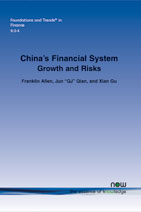China's Financial System: Growth and Risk
By Franklin Allen, Imperial College London, UK and The Wharton School University of Pennsylvania, USA, f.allen@imperial.ac.uk | Jun "QJ" Qian, Shanghai Advanced Institute of Finance, Shanghai Jiao Tong University, China, jqian@saif.sjtu.edu.cn | Xian Gu, School of Finance Central University of Finance and Economics, China, xiangu@cufe.edu.cn
Abstract
We provide an updated and comprehensive review of China's financial system and explore the possible challenges in the future. First, China's financial system has been dominated by a large banking sector, which has played an important role in financing the real economy in the past decades. With the interest rate liberalization, the profitability of banks will go down and the competition in the banking sector will become stronger in the future. Moreover, this sector still needs to meet the challenge to reduce the amount of nonperforming loans. Second, the role of the stock market in allocating resources in the economy has been limited and ineffective. However, with the rapid growth of the markets and the introduction of more financial products, financial markets are expected to play a more important role in the economy going forward. Third, a nonstandard sector that consists of alternative financing channels is the most successful part of the financial system in terms of supporting the growth in the past decades. The co-existence of this sector with banks and markets can continue to support the growth of private and local government firms. Finally, in order to sustain the economic growth in China, policies need to reduce the likelihood of damaging financial crises, including a banking sector crisis, a real estate or stock market crash, and a "twin crisis" in the currency market and banking sector.
China's Financial System: Growth and Risk
China's Financial System: Growth and Risks provides an updated and comprehensive review of China's financial system and compares it with financial systems in other countries. It reviews what has worked and what has not within the markets and intermediaries in China, and further considers the effects of the recent development of China's financial system on the real economy. It also examines a non-standard financial sector, which operates beyond the markets and banking sectors and consists of alternative financing channels, governance mechanisms, and institutions. Finally, the authors provide prospects for future research on several unresolved issues including how China's financial system can integrate into the world's markets and economy without being interrupted by damaging financial crises.
China's Financial System: Growth and Risks draws four main conclusions about China's financial system and its future development. First, compared with other developed and emerging economies, China's financial system has been dominated by a large banking system. Second, China's financial markets have witnessed significant development, however, their current scale and importance are not comparable to those of the banking sector and they may not be effective in allocating resources in the economy. Third, the alternative financial sector has played an important role in satisfying the financing demand and maintaining the high growth rate in the real economy. Finally, a significant challenge for China's financial system is to avoid damaging financial crises that can severely disrupt economic stability.
